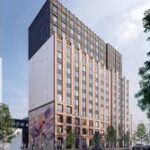
Brownsvillehttps://theworldfinancialforum.com/participate/
Goldman Sachs, via its Urban Investment Group (UIG), is funding $170 million for 326 Rockaway Avenue, a 14-storey, 216-unit, Brownsville, Brooklyn, affordable housing complex. This marks a significant stride towards solving New York City’s long-standing housing crisis. This demonstrates how Goldman Sachs seeks to transform its business image from a purely profit-driven firm to one that seeks to create sustainable, long-term impacts.
The development includes a mix of studios and one-, two-, and three-bedroom apartments, with 130 units reserved for formerly homeless New Yorkers—offering critical stability and support—while the remaining 85 units cater to families earning at or below 50–60 per cent of the Area Median Income (AMI). Rents range from $1,095 to $2,301 per month, positioning the project within reach of many households who might otherwise face displacement.
Beyond its residential function, the building incorporates 4,246 square feet of community space and 1,618 square feet of ground-floor retail, designed to serve both residents and the broader Brownsville neighborhood. This dual-use design ensures that the project does not stand in isolation but becomes a focal point for local activity and engagement.
Green, Humane, and Artistically Alive
Reflecting Goldman Sachs’s dual commitment to sustainable architecture and community uplift, 326 Rockaway achieves Passive House certification, runs entirely on electricity, and utilises rooftop solar photovoltaics. These features not only reduce the carbon footprint but also lower long-term operating costs, creating resilience against rising energy prices. It challenges the perception that eco-conscious design is incompatible with affordability.
Visually, the project distinguishes itself with a 150-foot mural titled “Brownsville, King of Love”, created by ArtBridge in collaboration with local artist Victor “Marka27” Quiñonez.
The artwork celebrates Brownsville’s hip-hop heritage and emerges as Brooklyn’s largest outdoor mural, embedding the building into the neighbourhood’s cultural fabric. It signals to residents that this project is not just about housing but about pride, history, and identity.
Celebrating the building’s completion, which occurred in phases from August 7, 2025, to August 7, 2026, marks a shift towards Brownsville’s brand-new merged building model, which models holistic urbanism by integrating sustainability, accessible culture, and community-driven housing. This structure exemplifies sustainable urbanism alongside culture-driven, collaborative housing finance that blends public and private sectors.
A Multifaceted Affordable Housing Project
The development consists of studios and one-, two-, and three-bedroom apartments, including 130 units set aside for previously homeless New Yorkers, which provides essential stability and support, while the other 85 units support families at 50–60 percent of the Area Median Income (AMI).
Monthly rents for the units are set between $1,095 and $2,301, which expands access to a greater number of families who are at risk of displacement.
The building also contains 4,246 square feet of community space and 1,618 square feet of retail space on the first floor to serve the residents of the building and the greater Brownsville community. The integrated design approach ensures that the development is not an ‘add-on’ but becomes a part of the neighbourhood, therefore integrating the building with the community.
Green, Humane, and Artistically Alive
In line with the community-focused and sustainable architecture goals of Goldman Sachs, 326 Rockaway is certified as a Passive House, runs on electricity-only operation, and has rooftop solar photovoltaics.
These eco-friendly design and construction features not only mitigate carbon emissions but also offset long-term operating costs, protecting these homes against future energy price increases. It challenges the perception that eco-conscious design is incompatible with affordability.
Effects and Future Perspective
This single investment further cements Goldman Sachs’s increasing investment in transforming the affordable housing landscape in the city. Its Urban Investment Group has invested nearly $11 billion in New York City since 2001, funding more than 150 projects, including the creation of over 60,000 affordable housing units, as well as retail, healthcare, community facilities, and jobs.
City officials have articulated more than once that investments like 326 Rockaway do not serve as band-aid solutions. They demonstrate a pathway to the development of affordable housing that can be economically sustainable, socially equitable, and environmentally responsible. For Brownsville—a neighbourhood laden with underinvestment and a lingering stigma—the development offers a visible indicator of revitalisation.
The housing crisis in the city and the lesson learnt is that multi-faceted approaches enabled by diverse actors who are willing to invest their time, energy, and knowledge are essential. 326 Rockaway showcases the positive outcome when banks, policymakers, and nonprofits collaborate; the outcome is not only well-designed but also socially groundbreaking.
In Brownsville, the development of 326 Rockaway is more than an address; it marks an investment in the refused and the promise of every New Yorker’s future, reminding New Yorkers that the path out of crisis is resilience and design.
Follow for more: https://www.goldmansachs.com/pressroom/press-releases/2025/170-million-dollar-commitment-to-affordable-housing-in-brooklyn